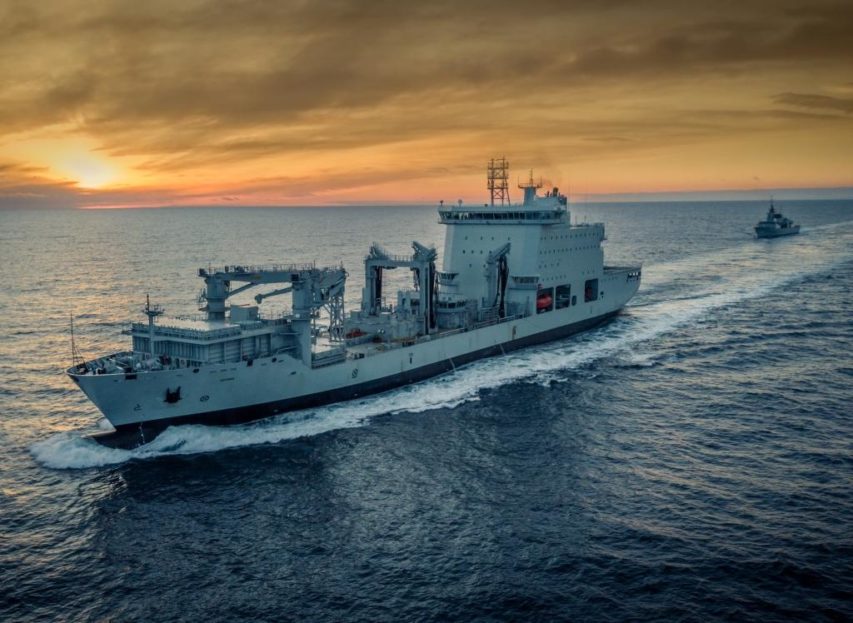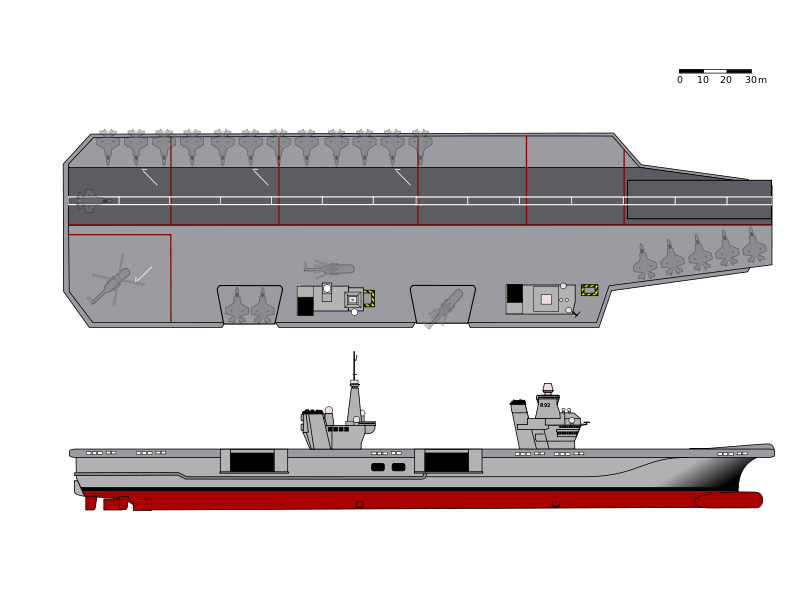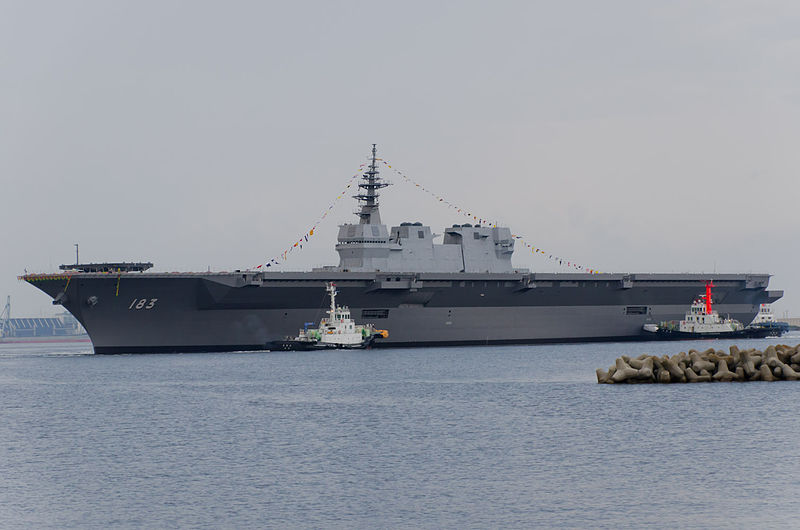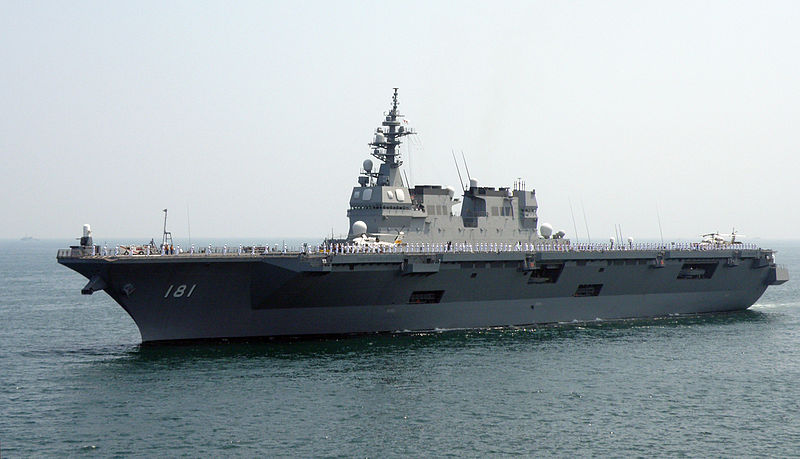BBC Earth Lab
Published on 23 Aug 2013James May discusses wings and propellers in these extra scenes from why boomerangs always come back.
June 21, 2018
Extra Scenes! James May Explains Boomerangs | Earth Lab
February 1, 2018
MV Asterix accepted by the Royal Canadian Navy
With the Queenston-class AOR ships still pinned to the drawing board, the Royal Canadian Navy has been reduced to borrowing support ships from allies and friendly nations to allow our combat ships to operate further from shore than a local fishing boat, the delivery and acceptance of the MV Asterix has to count as good news:
Davie Shipbuilding and Federal Fleet Services announced that following an intensive period of at-sea trials and testing, Asterix has been formally accepted by the Department of National Defence and has now entered full operational service with the Royal Canadian Navy (RCN) and Royal Canadian Air Force (RCAF).
As planned, Asterix performed daily replenishment-at-sea (RAS) exercises with the RCN and conducted extensive RCAF CH-148 Cyclone helicopter operations to prove and demonstrate the world-leading capabilities of the Resolve-Class Naval Support Ship. These exercises have included everything from dual RAS operations to helicopter landing, take-off and vertical replenishment trials.
Spencer Fraser, CEO of Federal Fleet Services commented “To deliver the first Canadian naval ship in over twenty years, the first supply ship in almost 50 years, and to reach FOC so efficiently and in such a short period of time is a testament to the hard work, dedication and dynamism of the teams at Davie and FFS. We are all very proud of our achievement and appreciative of the professional support we have received from DND and PSPC.”
Asterix has been leased by the government, and will be operated by a blend of merchant seamen and RCN/RCAF personnel as required for any given mission. She’ll remain an MV, not an HMCS and is not expected to be operated in “hot” environments where combat could occur. She will remain with the fleet at least until the planned-but-not-yet-started Queenston class ships are ready for service. Davie has offered to refit another ship for the RCN to lease (so we’d have one AOR for the East coast and one for the West), but so far the Trudeau government has resisted the offer.
January 4, 2018
HMS Ocean to be sold to Brazil
In The Register, Gareth Corfield sums up reports on the disposition of the Royal Navy’s current flagship after a 20-year service life:
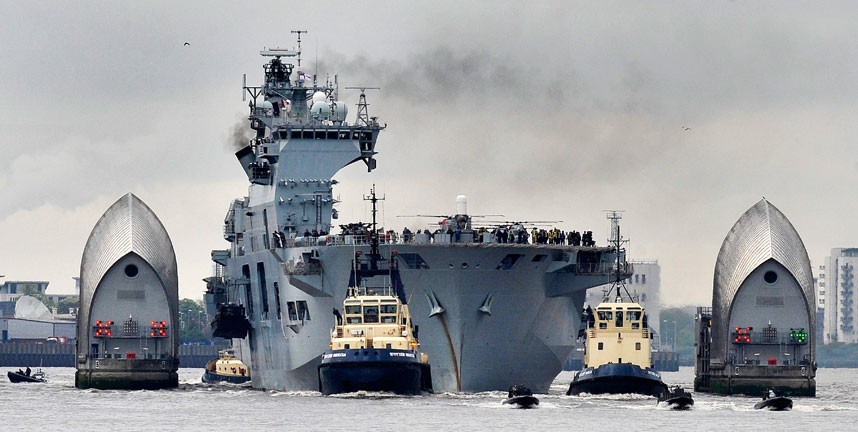
HMS Ocean at the Thames Barrier in 2012, being moved into position to support the Olympic Games in London.
The 22,000-tonne helicopter carrier, which returned from her last British deployment to the Caribbean just weeks ago, will be formally decommissioned from the RN in spring this year.
Although it was well known that Ocean was up for sale and that Brazil (as well as Turkey) were interested in buying the 20-year-old warship, confirmation of the deal and the purchase price were all “known unknowns” until now.
The news was broken by defence blog UK Defence Journal, citing a Brazilian journalist.
The Brazilian Navy’s end-of-year roundup statement, published on Christmas Eve 2017, also included the line: “Minister Raul Jungmann and the Brazilian Navy Commander Eduardo Bacellar Leal Ferreira took the opportunity to announce the purchase of the Royal Navy’s HMS Ocean multifunction vessel, valued at £84m sterling.”
A British Ministry of Defence spokesman told El Reg: “Discussions with Brazil over the long-planned sale of HMS Ocean are at an advanced stage, but no final decisions have been made. HMS Ocean has served admirably with us since 1998 and the revenue she generates will be reinvested in defence as we bolster our Royal Navy with two types of brand new frigates and two huge aircraft carriers.”
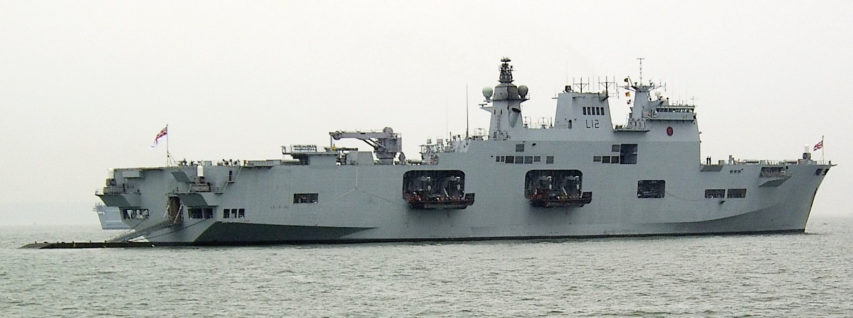
HMS Ocean at the 2005 International Fleet Review, showing Landing Craft on davits and Stern Ramp deployed.
Photo via Wikimedia.
At the Thin Pinstriped Line, Sir Humphrey explains why selling the ship now makes sense for the Royal Navy:
The big change to this requirement came in 2015, when the SDSR [Strategic Defence and Security Review]confirmed that the RN would keep both carriers in active service, and that neither would be CTOL [conventional take-off and landing]. Suddenly the RN found itself planning for a future where it would have two CVF available [the Queen Elizabeth class carriers], both of which would need to have manpower available to crew them. It also meant that the RN could make modifications to the ships to ensure that either of them could operate as an LPH [Landing Platform Helicopter] and carry helicopters and troops as well as a fixed wing airgroup.
This decision has had major ramifications for Ocean – suddenly the need for her to remain in service was gone. The LPH role that she would have done would now be filled by two newer and vastly more capable ships – the UK wasn’t losing capability but gaining it. In practical terms the RN actually would have more chance of an LPH being available without Ocean as CVF availability will be higher, both can role as an LPH (rather than CTOL which would not do this task) and with both platforms active, there is far less chance of the nightmare situation of both the CTOL carrier and the old LPH being stuck in refit at the same time.
From a capability perspective, the move to CVF makes a lot of sense. There are issues to be resolved (arguably the littoral manoeuvre capability offered by her landing craft, the vehicle issue and the question of what to do about afloat 1&2* command platforms and where to put them), but Ocean paying off is not going to remove the LPH capability from the UK toolkit.
The second problem has been that even if the RN wanted to run Ocean on, it has run out of manpower to do so. This year will see Queen Elizabeth at sea doing complex trials, drawing heavily on the Fleet Air Arm personnel to do so. As Prince of Wales (POW) stands up, more and more crew (usually very specialised engineers and the like) will be needed to bring her out of build. On the old plan this wouldn’t have been an issue – one would have gone straight into reserve. Now, the RN has to bring both carriers into service at roughly the same time (a helpful reminder of RN capability here is that it is the only navy in the world currently introducing two supercarriers into service at roughly the same time).
Ocean requires a lot of specialist crew who will be needed on QE and POW, and more importantly so will their reliefs. The manpower planners have not been working on the assumption of three carriers available and at sea (something the RN arguably has not done consistently for many years), and so the manpower structure is not designed to provide this. It could be changed, but would need many years to produce the right numbers of people in the right slots to deliver it without breaking manpower and causing retention challenges.
July 5, 2017
Helicopters Won’t Just Drop Like A Rock If The Engine Dies
Published on 6 Jun 2016
Autorotation in action: https://www.youtube.com/watch?v=pzWw5U3eCok
In this video:
In fact, you have a better chance at surviving in a helicopter when the engine fails than you do in an airplane. Helicopters are designed specifically to allow pilots to have a reasonable chance of landing them safely in the case where the engine stops working during flight, often with no damage at all. They accomplish this via autorotation of the main rotor blades.
Want the text version?: http://www.todayifoundout.com/index.php/2012/05/helicopters-wont-just-fall-like-a-rock-if-the-engine-dies-they-usually-can-be-landed-safely-this-way/
August 12, 2015
Who might buy a Mistral?
At the International Business Times, Christopher Harress reports on the two Mistral-class helicopter carriers France built for Russia and is now trying to find new homes for:
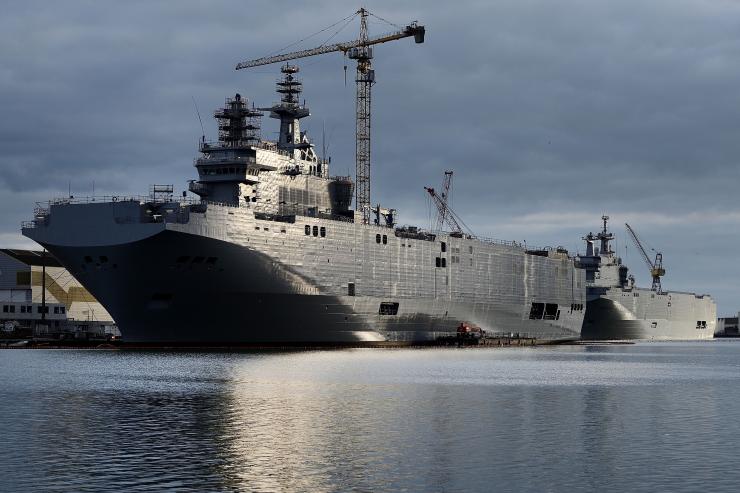
The Sevastopol (left) and the Vladivostok warships, two Mistral class LHD amphibious vessels ordered by Russia from STX France, are seen in St. Nazaire, France, Dec. 20, 2014. Jean-Sebastien Evrard/Agence France-Presse/Getty Images
Inside the sprawling dockyard in the ancient town of St. Nazaire in southwestern France sits $1.2 billion worth of unsold naval hardware. Despite having never left the dock, the two Mistral helicopter landing ships, originally built by France for use in the Russian navy, inadvertently have become involved in the growing international dispute between Russia and the West over the annexation of Crimea and the war in eastern Ukraine.
Now they are causing problems in France.
Two days after managing to negotiate a way out of the deal with Moscow that had become a divisive, ethical and political dilemma in Europe, France faces the fresh challenge of looking for a new buyer that has both the military need and the hard cash for the two 21,000 ton warships.
“I think this will be a difficult product to sell,” said Dakota Wood, senior research fellow of defense programs at the Heritage Foundation, a conservative Washington think tank. “Military ships are highly specialized and designed for a specific purpose that accounts for all the weapons systems and unique specifications that the navy in questions needs. In this case, the spacing and logistics to accommodate the unique aircraft that Russia was going to use. What other country shares those exact specifications?”
With Canada in the middle of a long, long election campaign, there’s no point in pretending that one or both of the ships might end up as part of the Royal Canadian Navy (unlike a few earlier reports), so France is forced to look further abroad for countries that have both the ready money (like Saudi Arabia) and the pressing need (uh, like Saudi Arabia).
May 4, 2015
More on the Mistral class
Last month, Strategy Page looked at the Mistral class ships, both the original French Navy ships and the two that have been built for — but not delivered to — the Russian navy:
Russia has not bought foreign warships for a long time, but the Mistral purchase was largely because of an eagerness to acquire Western shipbuilding technology and construction skills. This has already paid off, although not exactly how the Russians had planned. This became evident when a Russian official announced that the first Mistral would be built entirely in France. It had earlier been decided to have Russian shipyards build some sections of the first Mistral. It was quickly discovered that the Russian shipyard was not capable of building to the French specifications or do it according to the French timetable. The Russians expected to learn some valuable lessons from the French and, while embarrassing, this was one very valuable lesson. Russian shipyard officials have had their faces rubbed in the embarrassment of not being able to compete while using their current practices. Russian experts on Western production methods and techniques have long complained of the antiquated and inefficient methods still favored by Russian shipbuilders. Navy leaders have been complaining for decades about the poor quality of work coming out of Russian shipyards. The Mistral purchase was to put this to the test because additional Mistrals were to be built in Russia, with plenty of French supervision and technical assistance. That is also being withheld because of the Ukraine situation.
The Russian Navy has made some changes in the existing Mistral design. This Russian model will be called the Vladivostok Class and carry 30 helicopters (compared to 16 on the French version). The Vladivostoks will be armed with two AK-630 multibarrel 30mm autocannon for anti-missile defense. There will also be two quad-launchers of shoulder fired type anti-aircraft missiles (with a 5 kilometer range and does well against helicopters) and two or more DP-65 55mm grenade launchers for defense against divers.
The Vladivostoks will also be winterized for use in arctic conditions. The hull will be strengthened to deal with ice and the well deck door will completely close. The flight deck will have a deicing system and the ship will be modified to operate for extended periods in arctic conditions. There is also different electronics and this means a different arrangement of radomes and antennae.
In the aircraft handling areas below the deck, there will be more space made for the taller Ka-52K and Ka-29 helicopters. The Ka-52K is a navalized version of the Ka-52. In addition to being equipped with coatings to resist sea water corrosion, the K model will also have a lightweight version of the high-definition Zhuk-AE AESA radar used on jet fighters. This radar currently weighs 275 kg (605 pounds), but the helicopter version will weigh only 80 kg (176 pounds) and enables the Kh-52K to use the Kh-31 anti-ship missile. This weapon has a range of 110 kilometers and travels at high speed (about one kilometer a second). The Kh-52K can also carry the sub-sonic Kh-31 missile, which has a range of 130 kilometers. Both of these missiles weigh about 600 kg (1,300 pounds) each.
The French navy received the first of their own 21,500 ton Mistrals in 2006, with the second one arriving in 2007. Both were ordered in 2001. These two ships replaced two older amphibious landing ships. This gave France a force of four amphibious ships. The two Mistrals are also equipped to serve as command vessels for amphibious operations. The French have been very happy with how the Mistrals have performed.
I believe the French navy actually has three ships of this class in service: Mistral, Tonnerre, and Dixmude.
January 16, 2015
Germany and Canada are neck-and-neck … in the helicopter fail zone
Every now and again, I’ve reminded you about the sad, sad state of the Canadian Armed Forces’ long quest to get new helicopters. If any other western country has had a worse time trying to re-equip their military with capable helicopters, Germany must come close to the top of the list:
As early as the mid-1980s, German army aviation needed new helicopters. Its Vietnam-era Bell UH-1s and Sikorsky CH-53s had seen better days.
France, West Germany, Italy, The Netherlands and the United Kingdom got together in 1985 and drafted a scheme to develop a new fly-by-wire, multipurpose helicopter—the NH90. The U.K. soon left the project.
[…]
The NH90 itself struggled through its long years of development—and ultimately proved less than perfectly reliable. The Dutch have struggled to prevent corrosion in their naval NH90s that deploy aboard warships. The Germans have had problems of their own.
In Germany, the NH90 was originally supposed to open a new era of air-assault operations, wherein different variants of the NH90 would haul troops, vehicles and equipment in lightning-fast attacks behind enemy lines. There would also be a naval version.
But when the Cold War ended, funding became scarce. The German military had wanted more than 200 HN90s but ultimately ordered just 122, making large-scale air assaults unlikely. The first few machines arrived in December 2006.
Another seven years passed before Germany deployed the NH90. In April 2013, several of the copters began flying medical-evacuation missions in Afghanistan.
On June 19, 2014, an engine on one of the deployed NH90s exploded during a training mission over Uzbekistan. On Nov. 17, the German aviation security advisory board grounded the whole fleet.
November 9, 2014
A Canadian Mistral (or two)? Not likely say the experts
Remember those palmy days of summer, when the French helicopter carrier Mistral visited Canadian waters for a joint exercise with the Canadian Army? I half-joking referred to it as Canada “kicking the tires” … but the idea hasn’t gone away completely. In the Ottawa Citizen, David Pugliese reported earlier last week that the International Business Times had run an article about it.
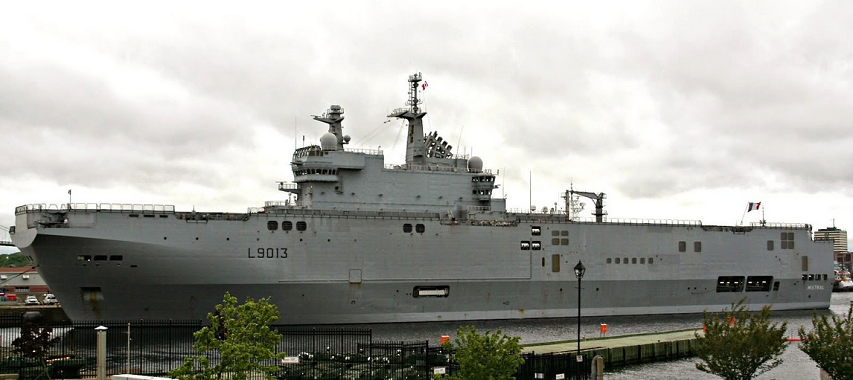
Halifax, Nova Scotia. FS Mistral (L-9013) is an amphibious assault ship, and lead ship of her class. She was commissioned in 2006. She features a landing craft dock, and helicopter facilities. Photo: Halifax Shipping News
The deal is worth $1.6 billion to $1.8 billion (different figures are out there) to the French. The Russians are interested in three of the ships. The French haven’t proceeded yet with the sale to Russia because of the situation in Ukraine.
But how probable is it that Canada would buy the Mistral-class ships?
Earlier this year, the Royal Canadian Navy was looking at buying surplus U.S. Navy supply ships. But that is not going to happen, RCN commander Vice Admiral Mark Norman told Defence Watch. What is being examined is the purchase of a commercial oiler (maybe).
The RCN is in dire need of an oiler/supply ship……not, at this point, an amphibious assault ship. So if there is an extra billion dollars or more around, the focus might be on acquiring an oiler/supply fleet to replace the decommissioned AORs.
Mistral-class ships are capable of carrying 16 helicopters, landing barges, up to 70 vehicles and 450 soldiers. They also come equipped with a hospital.
Canadian shipyards could also be expected to oppose such a purchase. There would be little for them (except maybe in-service support) in such an acquisition and they could argue that such a purchase would undermine the National Shipbuilding Procurement Strategy.
In September, I called the idea of Canada buying the Mistrals as the maritime equivalent of “pie in the sky”, despite a passionate article in the US Naval Institute News pushing the idea. They even showed what a Canadian Mistral would look like:

Mistral-class ship, Sevastopol configured as a NATO/Canadian Navy ship. CASR Image
So, on the surface, the idea isn’t likely to go anywhere for practical and economic reasons. But, a couple of days later Pugliese posted another article on the Mistral debate, responding to criticism from University of Ottawa professor Roland Paris:
If the Paris had actually read the articles in question he would have found out that the stories arose not from Hugh Segal’s comments from May but from the fact that the delegation led this week by French President François Hollande to Canada contained a significant contingent of the country’s defence industry representatives, including those from Mistral shipbuilder DCNS. That group included the firm’s diplomatic adviser.
In addition, sources have told Defence Watch that the delegation did indeed try to interest Canada in Mistral-class ships, as well as the FREMM class frigates.
Will they succeed with Mistral? Like I have mentioned a number of times at Defence Watch, including in the posting cited by Paris, the answer is likely no.
[…]
France, over the last two years, has embarked on a significant push into Canada to promote its defence products, particularly in the naval arena. With $35 billion on the table for shipbuilding who can blame them?
There was a specific reason a Mistral-class warship sailed across the Atlantic this summer to take Canadian soldiers on board for amphibious exercises. And it wasn’t about any close relationship between the French and Canadian militaries, although that might have played a minor role.
No, the French are interested in selling. They want to sell Canada warships, warship designs, and naval equipment like that on board the Mistral-class and the FREMM frigates. That is the reason the FREMM ship Aquitaine also visited Canada.
Personally, I’d love to see the RCN acquire a pair of Mistral-class ships, but they would not come cheap, they wouldn’t create a lot of jobs in Nova Scotia, Quebec, or British Columbia (and therefore wouldn’t be useful for gathering votes from those provinces), and they’d require the government to fully equip them … helicopters are extra. And we all know how the Canadian government can’t manage to say the word “helicopter” without wasting millions of dollars, never mind actually buying any.
October 17, 2014
Germany’s arms procurement plight
Peter Dörrie explains the German government’s current embarrassment due to the revelations about the desperate straits of all German military branches. The combination of delivery delays, cost overruns, technical faults, and low equipment availability mean that Germany could not come to the aid of NATO allies in a crisis:
The German armed forces have come clean. They’ve admitted they’re incapable of managing arms procurement — and have systematically neglected the hardware that’s already in service.
Military procurement and management in Germany have been under heightened scrutiny ever since Berlin’s attempt to buy an European version of America’s Global Hawk drone ended in miserable failure in mid-2013.
In late September, the German military sent an explosive report to parliament, confessing that half of the armed forces’ heavy equipment is unserviceable and can’t deploy in a crisis.
The German navy, for example, possesses 15 Sea King helicopters, but 12 of them are grounded. The situation is similar with respect to the naval Sea Lynx helicopter — just four out of 18 can fly — and the heavy-lifting CH-53 helicopter. Sixteen out of 43 CH-53s are functional.
The Luftwaffe can field only 80 Typhoon and Tornado fighters, out of 140 on the books. So short of equipment, at present Germany would be powerless to respond if a fellow NATO member were to ask for military assistance.
And the bad news doesn’t stop there. On Oct. 6, Defense Minister Ursula Von Der Leyen released a report by an outside consultancy analyzing the military’s nine biggest weapons purchases.
The report is damning. Every single procurement effort suffers some combination of cost overruns, delays and technical shortfalls. And owing to the ministry’s unwillingness or inability to negotiate proper contracts, the government has had to pay for the overruns itself. The arms manufacturers waltz away with their full fees.
This is sounding disturbingly similar to Canada’s military procurement problems.
September 22, 2014
A Canadian Mistral? What’s the maritime equivalent of “pie in the sky”?
A few months back, the French amphibious assault ship Mistral took part in joint exercises with Canadian troops from the Royal 22e Régiment (the “Van Doos”). I wondered at the time if it might be an opportunity for the RCN to “kick the tires” of the Mistral with an eye to eventually adding that to their theoretical shopping list (if they ever manage to get anything built this decade). At USNI News an opinion piece by Jim Dorschner looks at the benefits to NATO if the RCN leased one of the Mistrals being built for Russia while NATO itself took on the other one:
The September decision by France to withhold delivery of two Mistral-class Landing Platforms Helicopter (LPH) building for Russia is an opportunity for NATO, the Royal Canadian Navy (RCN) and for the French shipbuilding industry and economy. France should not suffer economically for taking a stand against Russia’s aggression toward Ukraine. Rather, NATO, France and Canada can benefit if a little mutually beneficial creativity is applied.
While France desperately wants to complete the two amphibious warships — and get paid for them — NATO and Canada need the capabilities these ships can provide.
For Canada, an LPH would help buttress logistic support for the upcoming Canadian Joint Support Ship (JSS). The replacement to Canada’s fleet oilers originally required a level of expeditionary capabilities which were ultimately not included in the final ship design.
Furthermore, while one of the Russian Mistrals is already undertaking sea trials and the second is scheduled for completion in 2016, the first of three new Queenston-class JSS for the RCN will not even begin building in Vancouver until 2017 or 2018 at best, with delivery by 2019 or 2020.
It was just announced that one of the two the current support ships HMCS Protecteur and the three Tribal-class destroyers HMCS Algonquin, HMCS Athabaskan, and HMCS Iroquois will be withdrawn from service immediately, and the Queenston-class are not going to be built any sooner.

Mistral-class ship, Sevastopol configured as a NATO/Canadian Navy ship. CASR Image
A RCN Mistral could operate the full range Canadian helicopters, including CH-148 Cyclones and CH-147F Chinooks. Ideally, Canada should obtain 6-8 additional Cyclones configured for the Commando Helicopter role as part of a financial settlement with Sikorsky over the Maritime Helicopter Program (MHP). Commando Cyclones would be optimized for Special Operations, tactical assault, medical evacuation and utility missions, with troop seats in place of maritime sensors, though retaining the CH-148’s FLIR system.
The make-up of a Tailored Air Group (TAG) for the RCN LPH would depend on the mission. A mix of Commando Cyclones, Griffons and Chinooks for amphibious, SOF, Arctic support and humanitarian operations. Cyclones for maritime security and ASW task forces. Exchange aircrew from the US Marine Corps, the Royal Navy Commando Helicopter Force and the Royal Danish and Norwegian Air Forces should be embedded within the Cyclone squadron forming the core of the TAG. This is critical for building expertise and interoperability among Arctic and NATO partners. By way of building a more direct partnership, Resolute could regularly embark RDAF EH-101 Merlin tactical helicopters and MH-60S Seahawk maritime helicopters.
Not least of the challenges facing the RCN would be manning. Fortunately, Mistral was designed from the beginning to operate with a small crew – just 20 officers, 80 petty officers and 60 sailors.
The foremost challenge for Canada may be convincing the government and the public that obtaining a Mistral LPH for the RCN is sensible and affordable, despite being outside the NSPS construct. Given the challenges now emerging for NATO member states and for Canada itself, the answer is surely a resounding ‘Yes’.
Given the current government’s allergy to spending actual money on military priorities (as opposed to nice-but-cheap uniform changes for photo ops), this grand notion is probably dead in the water with no hopes of success … but it’d be a nice boost for the RCN, and nearly as useful for the Canadian Army and RCAF. But it wouldn’t win key voting blocks in Halifax or Vancouver.
October 10, 2013
Replacing the Sea King – a British alternative
At Think Defence, Fedaykin wonders if the best solution for the Royal Canadian Navy’s Sea King helicopter might just be the Merlin which is in Royal Navy service:
With the Canadian government threatening to cancel the CH-148 contract, the sending of team to inspect Royal Navy Merlin is an interesting development.
Whilst the Merlin has developed a bit of a reputation for being fragile and expensive to maintain it has nevertheless seen many years of service now and is finally catching its second wind of maturity.
The Royal Navy is upgrading 30 Merlin from HM1 to HM2 standard leaving 8 airframes unchanged. Initially, thinking was these 8 spare airframes would probably form part of Crowsnest getting a permanent AEW fit. Sensibly (in my opinion) the MOD and navy has decided that Crowsnest will instead be a quick fit solution to any of the HM2 fleet ensuring that we don’t end up with “fleets within fleets”.
That leaves 8 standard HM1 going spare and possibly a home for them.
If the Canadian government was to suck up the embarrassment they could buy the AW Merlin HM2 with the 8 HM1 being given to them at a throw away price as a hot swap to get them going.
Once new build HM2 become available off the line the older HM1 in Canadian service can be upgraded to the common standard. The second article does clearly state the Canadian team did look at the HM1 in particular so is a happy solution close to hand.
The main barrier as it stands is the Omni-shambles of the Victoria class procurement, the Canadian public is not exactly happy about that disaster despite a significant proportion of blame being laid at their own door.
The UK does not do enough in terms of defence co-operation with Canada, New Zealand and Australia and there is much we can learn from each other.
H/T to Tony Prudori for the link.
September 5, 2013
Sea King replacement program branded as “the worst in Canada’s history”
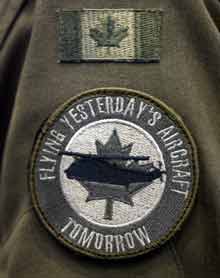 The Royal Canadian Navy is still operating the Sea King helicopter — which is 50 years old — and the planned replacement helicopters appear to be no closer to delivery than they were 20 years ago:
The Royal Canadian Navy is still operating the Sea King helicopter — which is 50 years old — and the planned replacement helicopters appear to be no closer to delivery than they were 20 years ago:
A naval helicopter procurement program described as the worst in Canada’s history was doomed from the start but could be made “viable and operationally relevant” if the federal government urgently adopts a new approach, says a confidential new report obtained by CBC News.
The independent evaluation of the multibillion-dollar purchase of 28 CH-148 Cyclone helicopters to replace a 50-year-old fleet of Sea Kings, obtained by CBC News Network’s Power & Politics host Evan Solomon, concludes the government can get the problem-plagued program back on track by negotiating with primary supplier Sikorsky to “re-scope” the project’s structure, specifications and delivery approach.
“[The] project could be viable and operationally relevant with a new structure and governance model as described in our recommendations,” reads the report from Hitachi Consulting.
[…]
“A fundamental problem existed at the outset of this project — this set the stage for significant misalignment,” reads the key finding.
The report says the government believed it was buying an “off-the-shelf” product by Sikorsky — a conclusion also drawn in a 2010 auditor general’s report. Yet the project should have been treated as a development program because the “state-of-the-art” aircraft incorporates advanced technology and an in-service support capability “that is likely unsurpassed in the world today,” according to the report.
While the fleet was to begin delivery in late 2008, so far only four of the Cyclone helicopters have been delivered — and only on an “interim” basis. The government won’t formally accept them because they don’t fully meet the specifications.
Last year, then defence minister Peter MacKay cited the Sikorsky deal as an example of how procurement can “go badly wrong.”
“This is the worst procurement in the history of Canada, including the $500-million cancellation costs that are attached to the maritime helicopter program and then the costs of the further maintenance to fly the 50-year old helicopters,” he said at the time. “They’re going to go right out of aviation service and into the museum in Ottawa. And that’s not a joke.”
H/T to Mark Collins for the link.
September 3, 2013
Britain’s new aircraft carriers in the news again
It’s from the Daily Mail, so a certain level of de-hystericization is called for…along with salt to taste. First, the discovery that the two carriers will initially be without radar for early warning of incoming planes and missiles:
The Royal Navy’s new aircraft carriers could set sail without a crucial radar which warns commanders of incoming enemy warplanes and missiles.
A damning report by MPs reveals the Crowsnest early warning system will not be ready until six years after the first of the £5.5billion Queen Elizabeth-class warships enters service in 2016.
Delays in fitting the ‘eyes in the sky’ system to military helicopters until 2022 were a ‘concern’, the Commons’ Public Accounts Committee (PAC) says today.
And the costs incurred by changing the planned acquisition of F-35 aircraft to equip the carriers is rather eye-watering:
The bill for the two new warships, given the green light in 2008, is almost twice the original £3.6billion — and there are ‘huge risks’ it will increase further, says the report.
MPs heap criticism on the Coalition for wasting money after a U-turn over the type of warplanes to fly from the aircraft carriers.
In 2010 ministers controversially decided to scrap the last Labour government’s plans to buy a fleet of jump jets, which take off and land vertically.
Instead, Prime Minister David Cameron ordered conventional versions of the US-built F-35 Joint Strike Fighter that would need catapults and arrester gear to take off from and land on the vessels.
But this was based on ‘deeply flawed information’, say the committee. When the cost of fitting the ships with ‘cats and traps’ more than doubled to £2billion, Mr Cameron flip-flopped and returned to buying the jump jet.
The move cost a staggering £74million in squandered in lost man hours, administrative costs and needless planning.
Labour MP Margaret Hodge, the PAC’s chairman, said: ‘The Committee is still not convinced that the MOD has this programme under control. It remains subject to huge technical and commercial risks, with the potential for further uncontrolled growth in costs.’
The switch back to the jump jet was made last year. Back in 2010, I was rather pessimistic that the carriers would even be built and I suggested that India would likely take them off the Royal Navy’s hands once they were complete.
August 12, 2013
The controversy over Japan’s latest “destroyer”
Apparently our eyes can deceive us. For most people looking at this image — at least if they know much about naval vessels — the description that comes to mind is “aircraft carrier”:
However, for constitutional reasons she is officially classified as a “destroyer”. In the South China Morning Post, Stefan Soesanto explains why this classification matters:
The Izumo‘s distinctive features certainly do not resemble anything one would typically classify as a destroyer. Indeed the warship currently under construction in Yokohama harbour is an aircraft carrier in anything but in name. Its size, tonnage and speed are closer to the US Essex aircraft carrier class, than to any of the two previous helicopter destroyers Japan has built so far.
At a cost of US$1.14 billion, the Izumo is officially conceptualised to host up to 14 helicopters whose missions would range from anti-submarine warfare and maritime border surveillance to humanitarian relief operations. In this regard, the Izumo‘s objectives are identical to the two Hyuga-class helicopter destroyers that were put into service in 2009 and 2011.
The current discussion among analysts and military brass as to whether Japan’s helicopter destroyers are considered aircraft carriers is not new. According to The Japan Times, Maritime Self-Defence Force chief of staff Admiral Keiji Akahoshi stated in 2009 that the Hyuga-class falls outside the conventional definition of an aircraft carrier because it lacks a fair degree of offensive functions. This argumentation has been notably employed by the Japanese government to circumvent Article 9 of the peace constitution to portray its helicopter destroyers as purely defensive military assets.
While Beijing’s criticism towards the Hyuga-class has been largely used as a means to support its own aircraft carrier expansion plans, the unveiling of the much larger Izumo has prompted widespread fears in China. Major Chinese media outlets went to great lengths to link Japan’s militaristic past to plans by the Japanese government towards constitutional revision. Indeed, the Chinese defence ministry even put out a statement saying that it is “concerned over Japan’s constant expansion of its military equipment”.
Reflecting on its own aircraft carrier plans, however, Chinese experts such as Li Daguang, professor at the National Defence University of the People’s Liberation Army, seem to make a simple leap of faith by suggesting that “the Chinese aircraft carrier Liaoning was mainly built for training purposes while the Izumo was built for real war”.
Of course, this isn’t a new thing, as a quick glance at the JS Hyūga also shouts “aircraft carrier” rather than “destroyer”:
April 2, 2013
Mistral in Russian is Vladivostok
Strategy Page on the largest purchase of Western military equipment by Russia since the end of the Second World War:
The Russian Navy intends to have its version of the French Mistral amphibious ships (the Vladivostok Class) carry 30 helicopters (compared to 16 on the French version) and have several other modifications to the ship itself. The Vladivostok Class ships will be armed with two AK-630 multibarrel 30mm autocannon for anti-missile defense. There will also be two quad-launchers of shoulder fired type anti-aircraft missiles (with a 5 kilometer range and good against helicopters) and two or more DP-65 55mm grenade launchers for defense against divers.
The Vladivostoks will also be winterized for use in arctic conditions. The hull with be strengthened to deal with ice and the well deck door will completely close. The flight deck will have a deicing system and the ship will be modified to operate for extended periods in arctic conditions. There is also different electronics and this means a different arrangement of radomes and antennae.
In the aircraft handling areas below the deck height will be higher for the taller Ka-52K and Ka-29 helicopters. The Ka-52K is a navalized version of the Ka-52 that went into production last year. In addition to being equipped with coatings to resist sea water corrosion, the K model will also have a lightweight version of the high-definition Zhuk-AE AESA radar used on jet fighters. This radar currently weighs 275 kg (605 pounds), but the helicopter version will weigh only 80 kg (176 pounds) and enables the Kh-52K to use the Kh-31 anti-ship missile. This weapon has a range of 110 kilometers and travels at high speed (about one kilometer a second.) The Kh-52K can also carry the sub-sonic Kh-31 missile, which has a range of 130 kilometers. Both of these missiles weigh about 600 kg (1,300 pounds) each.
[. . .]
Russia is buying two French Mistral class amphibious ships for $1.7 billion. This is the largest Russian purchase of Western weapons since World War II. The deal was delayed for a long time because the Russians demanded the transfer of shipbuilding and electronics technology (which is now agreed to).
The French navy received the first of the 21,500 ton Mistrals in 2006, with the second one arriving in 2007. Both were ordered in 2001. These two ships replaced two older amphibious landing ships. This gave France a force of four amphibious ships. The two Mistrals are also equipped to serve as command vessels for amphibious operations. The French have been very happy with how the Mistrals have performed.
The Mistrals are similar in design to the U.S. LPD 17 (San Antonio) class. Both classes are about 200 meters/620 feet long, but the LPD 17s displace 25,000 tons. The French ships are more highly automated, requiring a crew of only 180, versus 396 on the LPD 17. On long voyages on the open ocean, the Mistrals require as few as nine sailors and officers on duty (“standing watch”) to keep the ship going.

